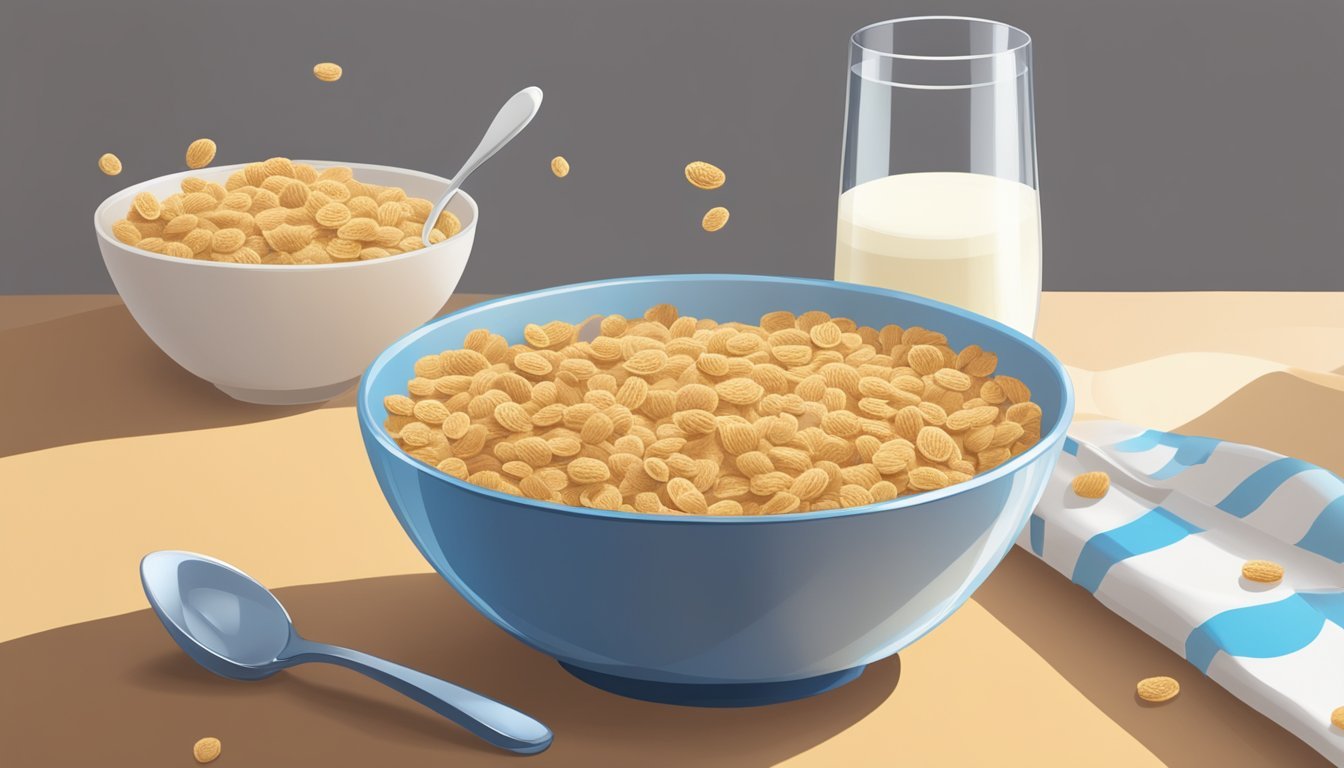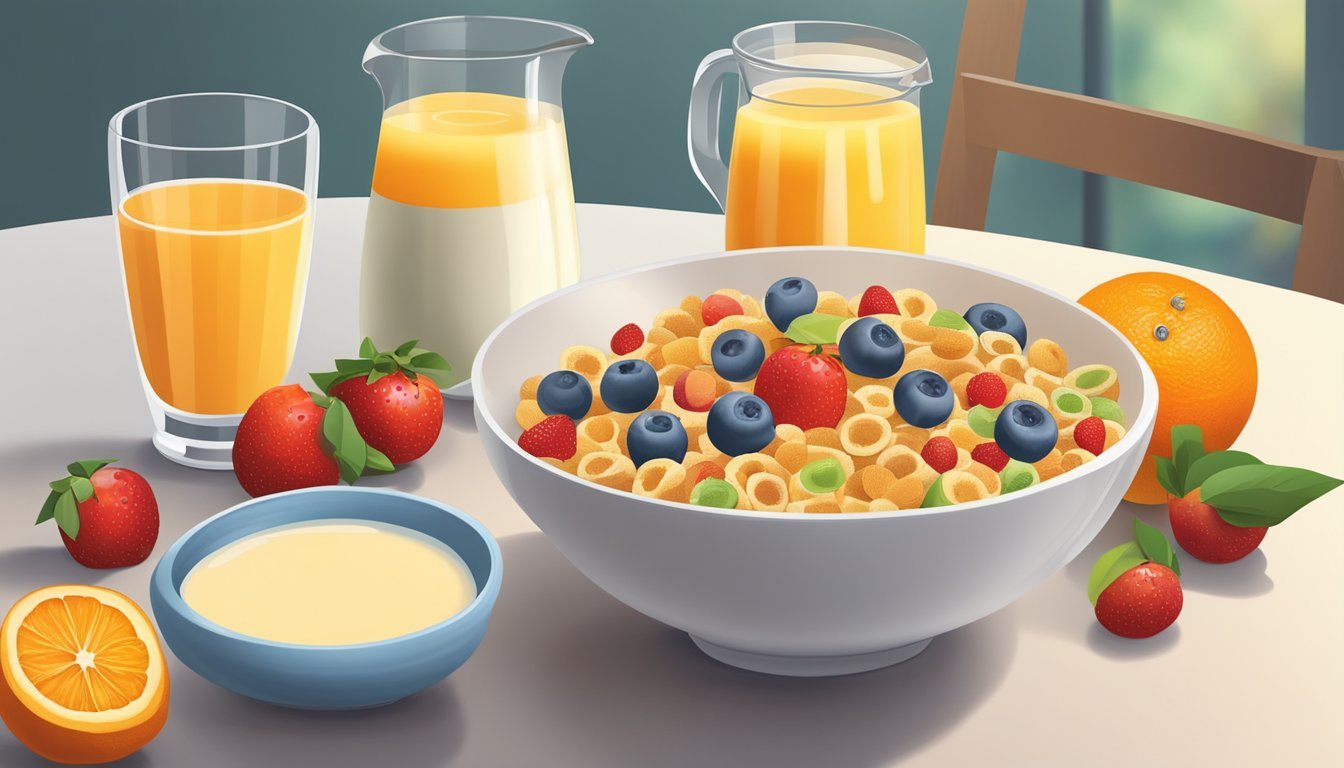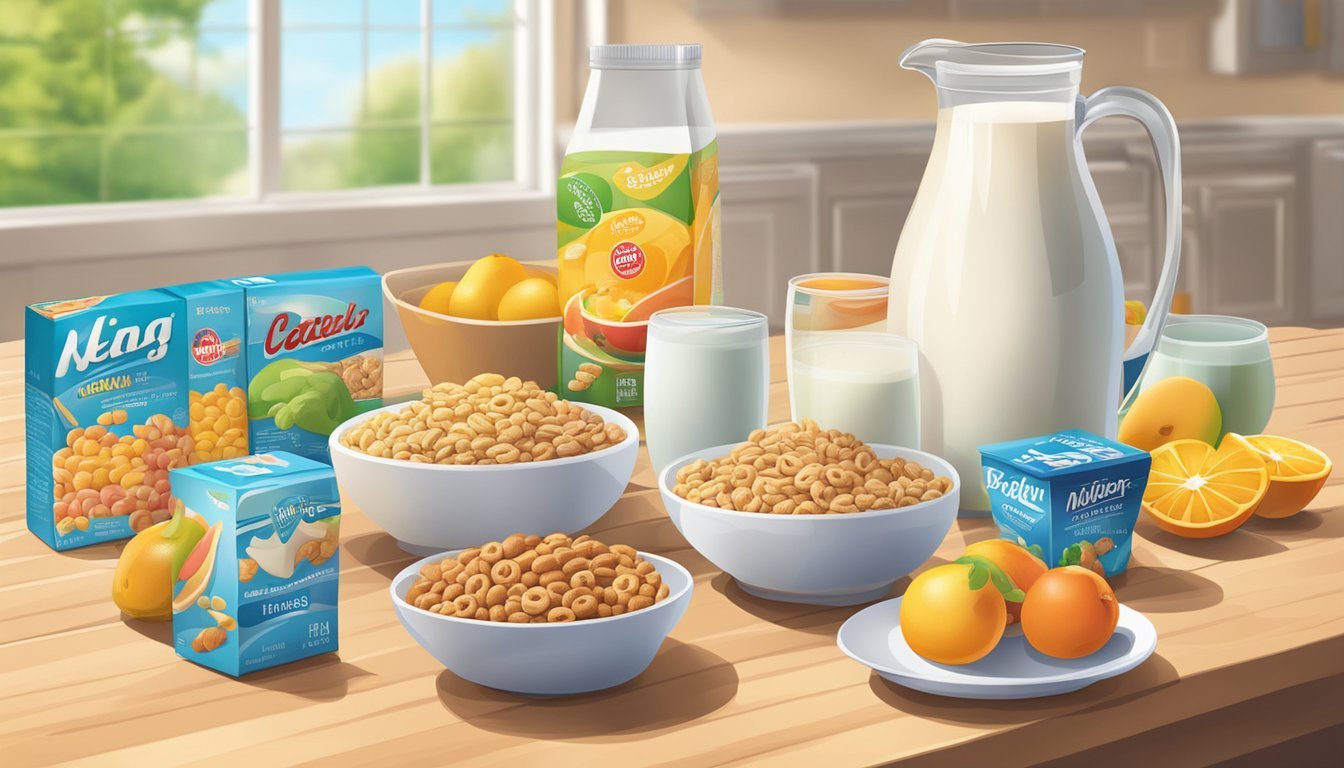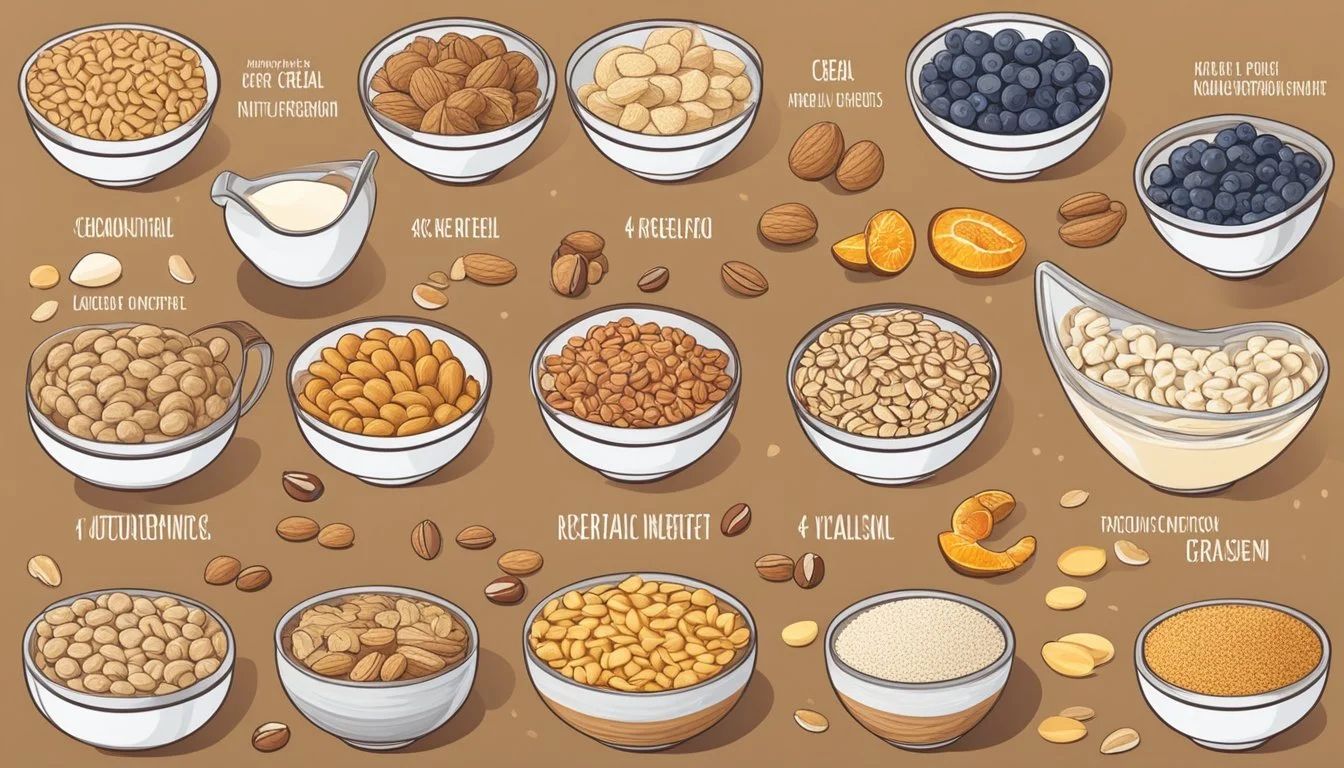Total Breakfast Cereal Nutrition Facts & More
Key Facts for a Healthy Start
Total breakfast cereal offers a nutritious start to the day, packed with essential vitamins and minerals. A single serving provides 100% of the daily value for 11 key nutrients, making it a convenient option for those seeking balanced nutrition.
One cup (30g) of Total cereal contains 100-110 calories, less than 1 gram of fat, and 2 grams of protein. The cereal is low in sugar, with only 5 grams per serving, and provides 3 grams of dietary fiber. These nutritional characteristics make Total a smart choice for health-conscious consumers.
When combined with milk, Total cereal becomes an even more complete meal. Adding half a cup of skim milk increases the calorie count to 140 and boosts protein content. This combination creates a satisfying breakfast that can help maintain energy levels throughout the morning.
Nutritional Profile of Breakfast Cereals
Breakfast cereals offer a diverse range of nutritional compositions. Their profiles vary widely depending on ingredients, processing methods, and fortification practices.
Protein Content
Most breakfast cereals contain moderate amounts of protein. On average, a serving provides 2-5 grams of protein. Some cereals, especially those made from whole grains or fortified with additional protein sources, may offer higher amounts.
Protein content can vary significantly between brands and types. For example, cereals containing nuts or seeds tend to have higher protein levels. Some specialized high-protein cereals may contain up to 10-15 grams per serving.
The quality of protein in cereals is generally considered incomplete, lacking some essential amino acids. Combining cereal with milk or yogurt can improve the overall protein profile of the meal.
Fiber: Soluble and Insoluble
Fiber content in breakfast cereals ranges from less than 1 gram to over 10 grams per serving. Whole grain cereals typically offer more fiber than refined grain varieties.
Cereals contain both soluble and insoluble fiber. Soluble fiber helps lower cholesterol and regulate blood sugar levels. Insoluble fiber aids digestion and promotes regular bowel movements.
Bran-based cereals often have the highest fiber content, sometimes exceeding 10 grams per serving. Oat-based cereals are particularly rich in soluble fiber, specifically beta-glucan.
Sugars and Added Sugars
Sugar content in breakfast cereals can vary dramatically. Some cereals contain less than 1 gram of sugar per serving, while others may have 15 grams or more.
Added sugars are a concern in many breakfast cereals. The American Heart Association recommends limiting daily added sugar intake to 25 grams for women and 36 grams for men.
Some cereals derive their sweetness from natural sources like fruit. Others use added sugars such as sucrose, high fructose corn syrup, or honey. Reading nutrition labels helps identify the amount and source of sugars.
Total Carbohydrate Breakdown
Breakfast cereals are primarily carbohydrate-based foods. Total carbohydrate content typically ranges from 20 to 30 grams per serving.
The carbohydrate profile includes:
Starch: The main component, providing energy
Fiber: Both soluble and insoluble
Sugars: Natural and added
Whole grain cereals often have a more complex carbohydrate structure, which can lead to slower digestion and a lower glycemic impact.
Vitamin and Mineral Fortification
Many breakfast cereals are fortified with vitamins and minerals. Common additions include:
B vitamins (thiamin, riboflavin, niacin, B6, folate)
Iron
Zinc
Vitamin D
Calcium
Fortification levels vary, with some cereals providing 100% of the Daily Value for certain nutrients per serving. This practice aims to address common nutritional deficiencies and enhance the overall nutritional value of the cereal.
The bioavailability of fortified nutrients can differ. For example, the iron used in cereal fortification may not be as readily absorbed as iron from animal sources.
Health Implications of Cereal Ingredients
Breakfast cereal ingredients can significantly impact health outcomes. The types of fats, carbohydrates, fiber, sodium, and cholesterol content all play crucial roles in determining the nutritional value and potential health effects of cereals.
Understanding Fats: Saturated and Unsaturated
Cereals contain varying amounts and types of fats. Saturated fats, often found in added oils or milk ingredients, can raise LDL cholesterol levels when consumed in excess. Unsaturated fats, particularly omega-3 fatty acids, may offer heart health benefits.
Some cereals include trans fats, which are linked to increased cardiovascular disease risk. Manufacturers have largely phased out trans fats due to health concerns.
It's important to check nutrition labels for fat content. Opting for cereals with lower saturated fat and no trans fats is advisable for maintaining heart health.
Whole Grains vs. Refined Carbohydrates
Whole grain cereals provide more nutrients and fiber compared to those made with refined grains. They contain the entire grain kernel - bran, germ, and endosperm.
Refined grains have been stripped of the bran and germ, reducing fiber, vitamins, and minerals. This processing can lead to rapid blood sugar spikes.
Whole grains are associated with reduced risks of type 2 diabetes, cardiovascular disease, and certain cancers. They also promote better weight management and digestive health.
Choosing cereals made primarily from whole grains can contribute to a more balanced and nutritious diet.
Dietary Fiber's Role in Digestion
Fiber is a crucial component in many breakfast cereals. It aids digestion, promotes regular bowel movements, and helps maintain a healthy gut microbiome.
Soluble fiber can help lower cholesterol levels and regulate blood sugar. Insoluble fiber adds bulk to stool and prevents constipation.
High-fiber cereals may reduce the risk of colorectal cancer and other digestive disorders. They also contribute to feelings of fullness, potentially aiding in weight management.
Aim for cereals with at least 3 grams of fiber per serving. Gradually increase fiber intake to avoid digestive discomfort.
Sodium and Cholesterol Contents
Many cereals contain added sodium, which can contribute to high blood pressure when consumed in excess. Low-sodium options are available for those monitoring their intake.
Some cereals may contain cholesterol from added ingredients like milk solids. Plant-based cereals are typically cholesterol-free.
Excess sodium intake is linked to increased cardiovascular disease risk. Choosing cereals with less than 140 mg of sodium per serving is recommended.
Reading nutrition labels helps identify sodium and cholesterol content. Pairing cereal with low-fat milk or plant-based alternatives can further impact overall cholesterol intake.
Cereal Brands and Varieties
The breakfast cereal market offers a wide array of options to suit different tastes and nutritional needs. From classic favorites to health-focused alternatives, consumers can choose from various brands and varieties.
General Mills' Cereal Range
General Mills stands as a major player in the cereal industry, producing numerous popular brands. Cheerios, one of their flagship products, comes in multiple flavors including the original and Honey Nut Cheerios. These whole-grain cereals provide essential nutrients and fiber.
Other General Mills cereals include:
Cinnamon Toast Crunch
Lucky Charms
Trix
Wheaties
Many of these options contain whole grain wheat as a primary ingredient, contributing to their nutritional value. General Mills has also introduced healthier versions of some classics, reducing sugar content and increasing whole grain percentages.
Health-Oriented Cereal Varieties
Health-conscious consumers can find cereals tailored to specific nutritional goals. Brands like Kashi offer whole-grain cereals with minimal added sugars and high fiber content. Examples include:
Kashi 7 Whole Grain Flakes
These cereals often incorporate seeds, nuts, and dried fruits for added nutrition and flavor. Some varieties focus on protein content, using ingredients like soy protein to boost their nutritional profile.
Oat-based cereals, such as plain oatmeal, provide a versatile and nutritious option. These can be customized with fresh fruits, vegetables, or nuts for a personalized healthy breakfast.
Cereals for Specific Dietary Needs
The cereal market has expanded to accommodate various dietary restrictions and preferences. Gluten-free options have become more prevalent, using alternative grains like rice or quinoa. Cereals fortified with vitamins and minerals cater to those seeking specific nutritional boosts.
Some brands offer low-sugar or sugar-free varieties for diabetics or those watching their sugar intake. Organic cereals have also gained popularity, appealing to consumers concerned about pesticide use and environmental impact.
For those following plant-based diets, many cereals are naturally vegan or have vegan variations available. These options often use plant-based ingredients to achieve desired textures and flavors without animal products.
Cereal Consumption and Daily Intake
Breakfast cereal can be a significant source of nutrients in the diet. Understanding proper serving sizes, recommended daily intake, and balancing cereal with other foods is key to maximizing nutritional benefits.
Measuring Serving Sizes
A typical serving size for breakfast cereal ranges from 30 to 45 grams, or about 3/4 to 1 cup. This amount provides approximately 100-150 calories, depending on the cereal type.
Measuring tools like cups or scales can help ensure accurate portions. Many cereal boxes include a serving size guide on the nutrition label.
It's important to note that people often consume larger portions than recommended, which can lead to excess calorie intake.
Recommended Daily Intake (RDI)
Breakfast cereals are often fortified with essential vitamins and minerals. A single serving can contribute significantly to the RDI of various nutrients:
Iron: 10-18 mg/day (varies by age and gender)
Calcium: 1000-1300 mg/day
Vitamin D: 600-800 IU/day
Vitamin A: 700-900 mcg/day
Vitamin C: 65-90 mg/day
Many cereals provide 25% or more of the RDI for these nutrients per serving. However, sodium content should be monitored, as some cereals can be high in salt.
Balancing Cereal with Other Foods
While cereal can be nutritious, it shouldn't be the sole focus of breakfast. Pairing cereal with other foods creates a more balanced meal:
Add fresh fruits for extra fiber and vitamins
Include low-fat milk or yogurt for protein and calcium
Sprinkle nuts or seeds for healthy fats and additional protein
This combination helps provide a wider range of nutrients and promotes satiety. It's also important to choose cereals with lower sugar content and higher fiber to support overall health.
Rotating cereals with other breakfast options throughout the week ensures dietary variety and prevents nutrient imbalances.
Preparing a Balanced Breakfast
Creating a nutritious breakfast with Total cereal involves thoughtful combinations and mindful choices. A well-rounded morning meal provides essential nutrients to start the day.
Pairing Cereal with Milk and Fruits
Total cereal serves as an excellent base for a balanced breakfast. Pour a serving of cereal into a bowl and add cold skim milk for a protein boost. The milk enhances the cereal's nutritional profile while providing calcium and vitamin D.
Fresh or frozen fruits make ideal toppings. Berries, sliced bananas, or diced apples add natural sweetness and extra fiber. These fruits contribute vitamins and antioxidants to the meal.
For added variety, try mixing different fruit combinations. Alternating between seasonal options keeps the breakfast exciting and nutritionally diverse.
Including Healthy Fats in Your Breakfast
Incorporating healthy fats into your Total cereal breakfast helps with nutrient absorption and promotes satiety. Sprinkle a tablespoon of chopped nuts like almonds or walnuts over your cereal.
Seeds such as chia, flax, or pumpkin seeds also provide beneficial omega-3 fatty acids. These additions not only boost the nutritional value but also add a satisfying crunch to your breakfast.
Consider a side of avocado toast to complement your cereal. The monounsaturated fats in avocados support heart health and provide a creamy contrast to the crunchy cereal.
Avoiding Excessive Sugar Intake
While Total cereal contains some sugar, it's important to be mindful of additional sweeteners. Opt for plain, unsweetened skim milk instead of flavored varieties to keep added sugars in check.
If extra sweetness is desired, use natural options sparingly. A drizzle of honey or a sprinkle of cinnamon can enhance flavor without significantly increasing sugar content.
Be cautious with pre-sweetened fruits. Choose fresh or frozen fruits without added syrups. This approach allows you to control the overall sugar content of your breakfast while still enjoying natural fruit sweetness.
Reading and Understanding Nutrition Labels
Nutrition labels provide essential information about the contents and nutritional value of breakfast cereals. Examining these labels carefully helps consumers make informed choices about their dietary intake.
Deciphering Ingredients Lists
Ingredients on cereal boxes are listed in descending order by weight. The first few items typically make up the bulk of the product. Look for whole grains as the primary ingredient for a healthier option.
Be aware of added sugars, which may appear under various names like corn syrup, dextrose, or maltodextrin. Artificial colors and preservatives are often listed near the end.
Some cereals include fortified vitamins and minerals. These are usually listed separately from the main ingredients.
Analyzing Nutritional Values
The Nutrition Facts panel displays key nutritional information per serving. Pay attention to the serving size, as it may differ from what you typically consume.
Calories, total fat, carbohydrates, and protein are prominently displayed. Check the fiber content - higher fiber cereals can aid digestion and promote fullness.
Added sugars are now listed separately from total sugars. Aim for cereals with lower added sugar content. Sodium levels are also important, especially for those monitoring salt intake.
Comparing Different Cereal Brands
When comparing cereals, use the percent Daily Value (%DV) as a quick guide. Higher %DV for vitamins and minerals indicates a more nutrient-dense option.
Consider the balance of nutrients. A cereal high in fiber but also high in added sugars may not be the best choice.
Compare similar serving sizes across brands for accurate comparisons. Some brands may list smaller serving sizes to appear lower in calories or sugar.
Look for cereals that offer a good balance of nutrients without excessive added sugars or sodium. Whole grain options generally provide more fiber and nutrients than refined grain cereals.
Alternative Cereal Options
Consumers seeking nutritious breakfast options beyond traditional cereals have several choices. These alternatives cater to various dietary needs and preferences while providing essential nutrients.
Exploring Non-Traditional Cereals
Whole grain-based cereals offer a nutritious start to the day. Muesli, a Swiss-style cereal, combines oats, dried fruits, and nuts without added sugars. It provides energy from complex carbohydrates and healthy fats.
Quinoa flakes serve as a protein-rich cereal option. They contain all nine essential amino acids and offer a gluten-free alternative to oat-based cereals.
Buckwheat groats, despite their name, are not related to wheat. These gluten-free seeds can be cooked and served as a hot cereal, similar to creamy wheat hot cereal.
Home-Made Cereal Recipes
Creating custom cereals at home allows control over ingredients and sugar content. A simple DIY option combines:
2 cups rolled oats
1/4 cup chopped nuts
2 tablespoons chia seeds
1 teaspoon cinnamon
1/4 cup dried fruit
This mixture can be stored in an airtight container and served with milk or yogurt.
For a warm option, try overnight oats. Mix equal parts oats and milk, add fruits and a drizzle of honey, then refrigerate overnight.
Gluten-Free and Allergen-Free Cereals
Many brands now offer gluten-free cereals made from rice, corn, or quinoa. These options cater to those with celiac disease or gluten sensitivity.
Allergen-free cereals avoid common triggers like nuts, soy, and dairy. Some use alternative grains like sorghum or millet as their base.
Grain-free granolas made with seeds and nuts provide a crunchy, low-carb option. These often contain fewer sugars than traditional granolas.
Plant-based milk alternatives like almond or oat milk pair well with these cereals, offering dairy-free breakfast solutions.
Impact on Weight Management
Breakfast cereals can play a significant role in weight management efforts. Their fiber and protein content, along with portion control, influence their effectiveness in various diet regimens.
Cereals in Weight Loss Efforts
Fiber-rich cereals contribute to feelings of fullness, potentially reducing overall calorie intake. A study of 11,005 women found that higher cereal consumption predicted significant weight loss of 2 kg or more. Protein in cereals helps maintain muscle mass during weight loss.
Some cereals are fortified with vitamins and minerals, supporting nutritional needs while restricting calories. Choosing whole grain options increases fiber intake, promoting digestive health and satiety.
Portion control is crucial when using cereals for weight management. Pre-portioned servings can help limit calorie consumption.
Cereals and Diet Regimens
Cereals fit into various diet plans due to their versatility. Low-fat diets often include cereals as a convenient, low-calorie option. High-fiber cereals support low-carb diets by providing complex carbohydrates.
Some weight loss programs use meal replacement shakes made with cereal ingredients. These provide controlled portions and balanced nutrition.
Timing of cereal consumption may affect weight management. Studies suggest eating breakfast, including cereal, might support weight loss efforts by reducing later-day cravings.
Cereal-based snacks can be part of a balanced diet plan, offering a healthier alternative to high-calorie options. Combining cereals with protein sources like milk or yogurt can enhance their satiety effect.
Cereal and Health Research Insights
Breakfast cereals have been the subject of extensive scientific research examining their impacts on various health outcomes. Studies have explored connections between cereal consumption and cardiovascular health, diabetes prevention, and cancer risks.
Studies on Cereal and Cardiovascular Health
Research indicates that regular consumption of whole grain cereals may contribute to improved cardiovascular health. A systematic review of 232 studies found associations between breakfast cereal intake and reduced risk of heart disease.
Whole grain cereals contain beneficial nutrients like fiber, B vitamins, and minerals that support heart health. Fiber helps lower cholesterol levels, while B vitamins may reduce inflammation.
Some studies suggest 3 or more servings of whole grain cereals per week could lower heart disease risk by up to 15-20%. However, more research is needed to confirm these findings.
Diabetes Prevention and Cereal Fiber
Cereal fiber appears to play a role in diabetes prevention. Studies have shown that diets high in cereal fiber are associated with a reduced risk of developing type 2 diabetes.
The insoluble fiber found in many breakfast cereals may help:
Improve insulin sensitivity
Slow glucose absorption
Promote feelings of fullness
A meta-analysis of prospective studies found that individuals consuming the highest amounts of cereal fiber had a 19% lower risk of developing type 2 diabetes compared to those with the lowest intake.
Whole grain cereals are particularly beneficial, as they provide both fiber and other nutrients that support blood sugar regulation.
Cereal Consumption and Cancer Risks
Research on cereal consumption and cancer risks has produced mixed results. Some studies suggest potential protective effects, while others show no significant association.
Whole grain cereals contain antioxidants and phytochemicals that may help reduce cancer risk. Fiber in cereals may also play a role in lowering colon cancer risk by promoting regular bowel movements.
A large European study found that high fiber intake from cereals was associated with a reduced risk of colorectal cancer. However, more research is needed to establish definitive links between cereal consumption and cancer prevention.
Fortified cereals may provide additional benefits through added nutrients like folic acid, which has been linked to reduced risk of certain cancers.
Nutritional Additions to Cereal
Breakfast cereals often serve as vehicles for essential nutrients, enhancing their nutritional profile beyond basic grains. Manufacturers fortify cereals with vitamins and minerals, while consumers can further boost nutrient intake through strategic combinations.
Fortified Cereals and Nutrient Boosting
Many breakfast cereals undergo fortification to increase their nutritional value. Common additions include vitamin D, iron, calcium, and B-vitamins like niacinamide, pyridoxine hydrochloride, riboflavin, thiamin mononitrate, and folic acid. These fortifications aim to address common nutrient deficiencies and support overall health.
For example, Total cereal provides 100% of the daily value for several vitamins and minerals in a single serving. This includes vitamin D for bone health, iron for blood health, and calcium for strong teeth and bones.
Cereal manufacturers may also add vitamin E, zinc, and vitamin B12 to their products. These additions can help consumers meet their daily nutritional requirements more easily.
Combining Cereals with Supplements
Consumers can further enhance the nutritional profile of their cereal by adding supplements or nutrient-rich foods. Mixing protein powder into cereal can boost protein intake, supporting muscle health and satiety.
Adding fresh fruits to cereal increases vitamin C, fiber, and antioxidant content. Nuts and seeds provide healthy fats, additional protein, and minerals like magnesium and selenium.
For those seeking specific nutritional benefits, specialized supplements can be incorporated. Omega-3 fatty acid supplements or probiotics can be taken alongside cereal to support heart and digestive health respectively.
It's important to note that while these additions can be beneficial, they should be part of a balanced diet and not replace whole food sources of nutrients.
Cereal in Different Cultures
Breakfast cereals have become a global phenomenon, with diverse regional variations and preferences emerging around the world. Cultural influences shape unique cereal offerings and consumption habits across countries and continents.
International Cereal Preferences
In the United States, sugary cereals often dominate shelves, while European countries tend to favor muesli and granola options. The UK embraces porridge as a traditional favorite. Asian markets see rice-based cereals gaining popularity, with flavors like green tea and red bean appealing to local tastes.
Japan offers unique cereal products like Furugura, a granola-like mix with dried fruits and nuts. In India, puffed rice cereals and regional grain-based options are common. Australia and New Zealand have developed their own iconic brands, such as Weet-Bix, a whole-grain biscuit cereal.
Cereal Adaptations Across the Globe
Cereal manufacturers adapt their products to suit local palates and nutritional preferences. In Latin America, corn-based cereals are prevalent, reflecting the region's culinary heritage. Middle Eastern markets see an increase in date-flavored and halal-certified options.
Some countries focus on fortified cereals to address specific nutritional needs. For example, iron-fortified cereals are popular in regions with high rates of anemia. Whole-grain cereals are gaining traction globally as health consciousness rises.
In China, hot cereal options like congee compete with Western-style cold cereals. European brands often emphasize organic and natural ingredients to appeal to health-conscious consumers. The global trend towards plant-based diets has also influenced cereal offerings, with more vegan and dairy-free options available worldwide.









